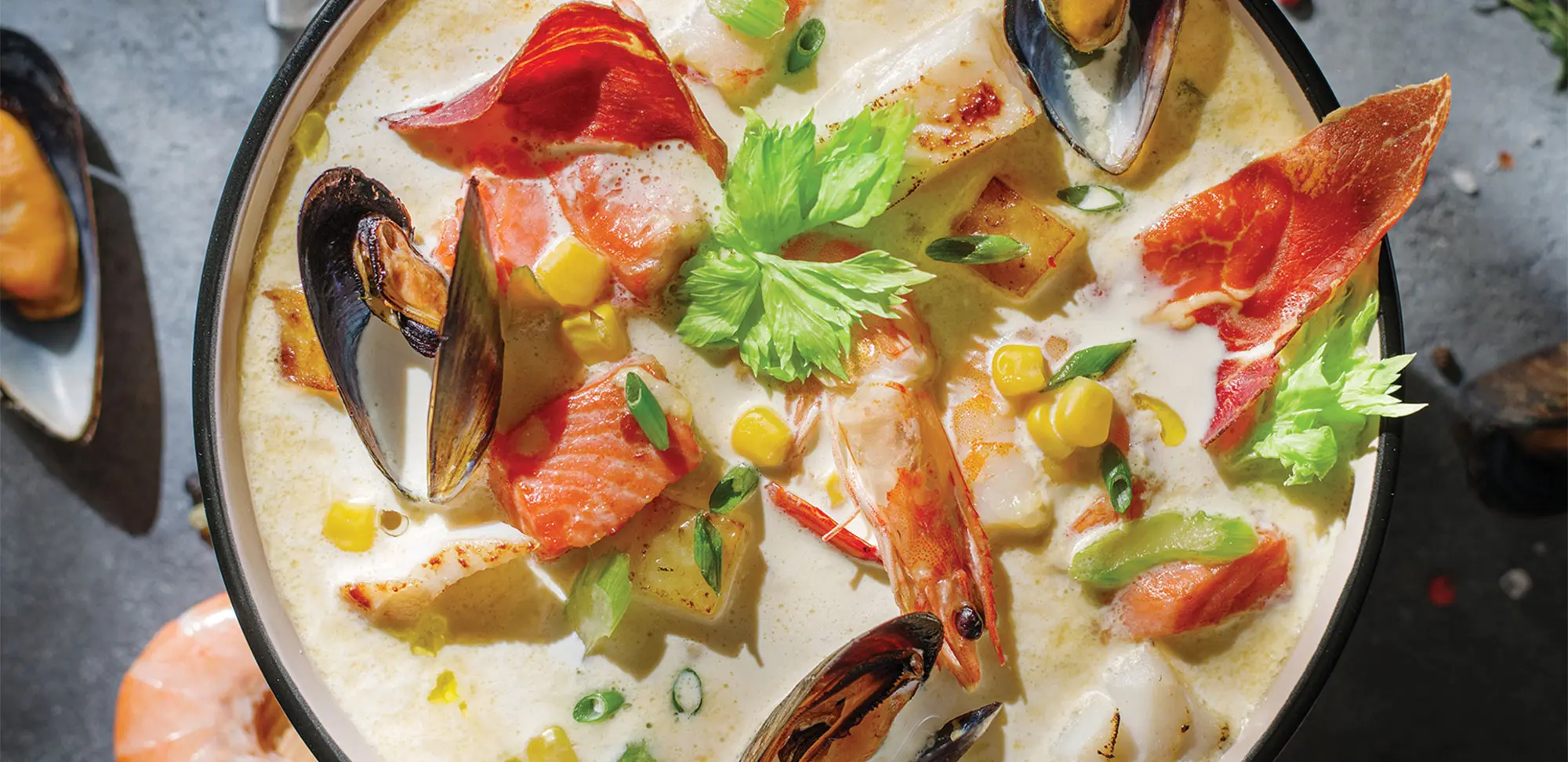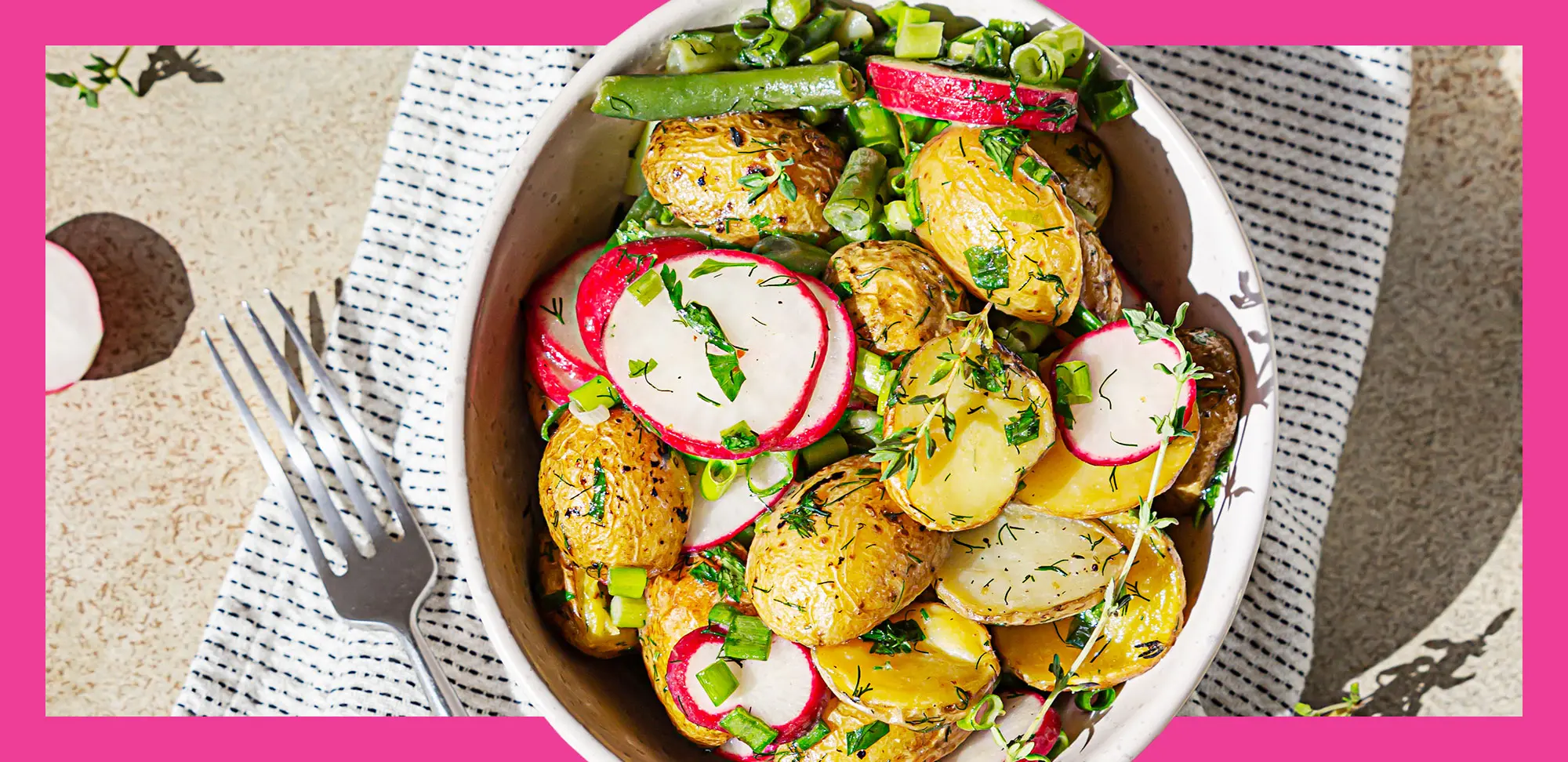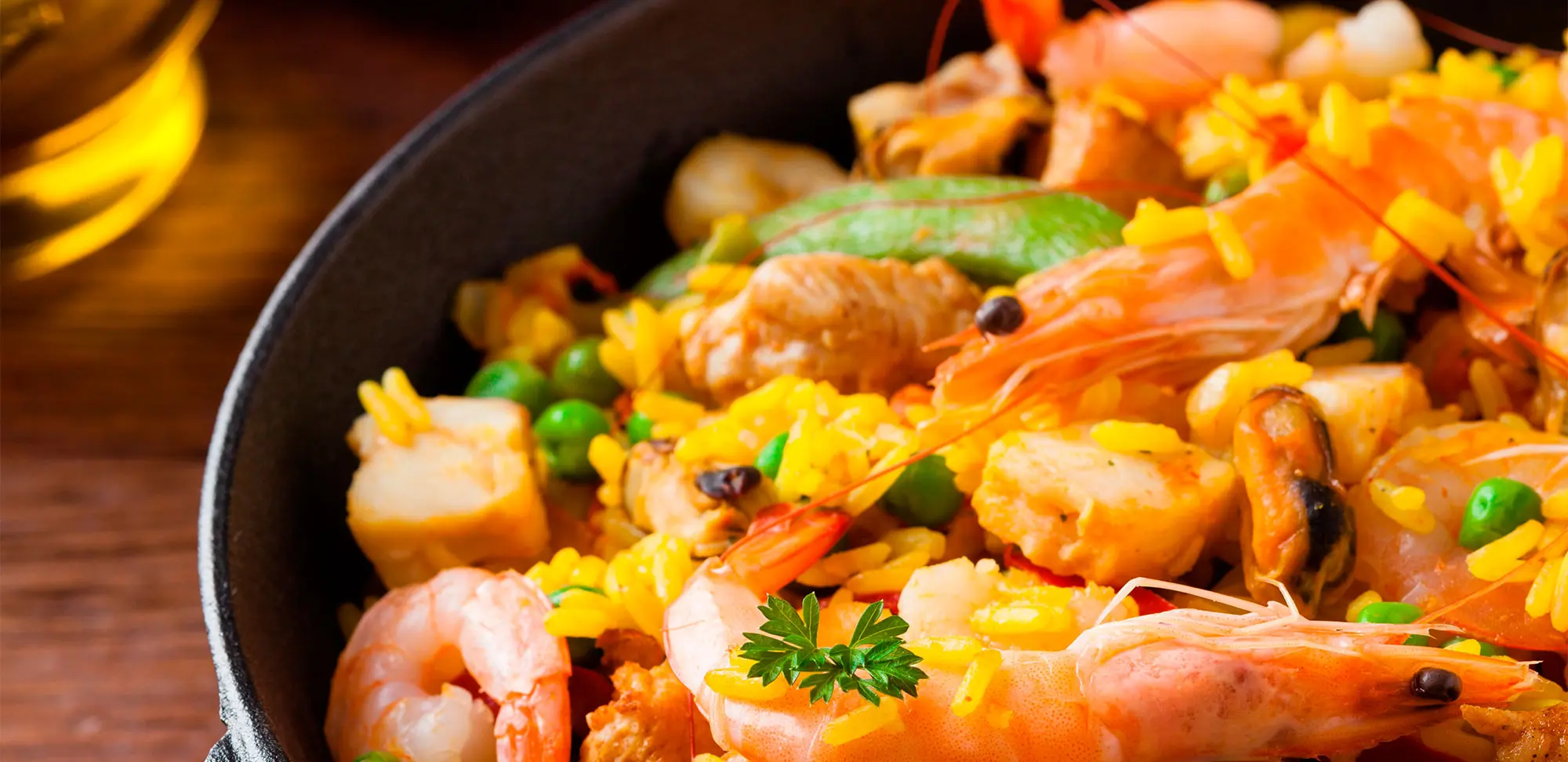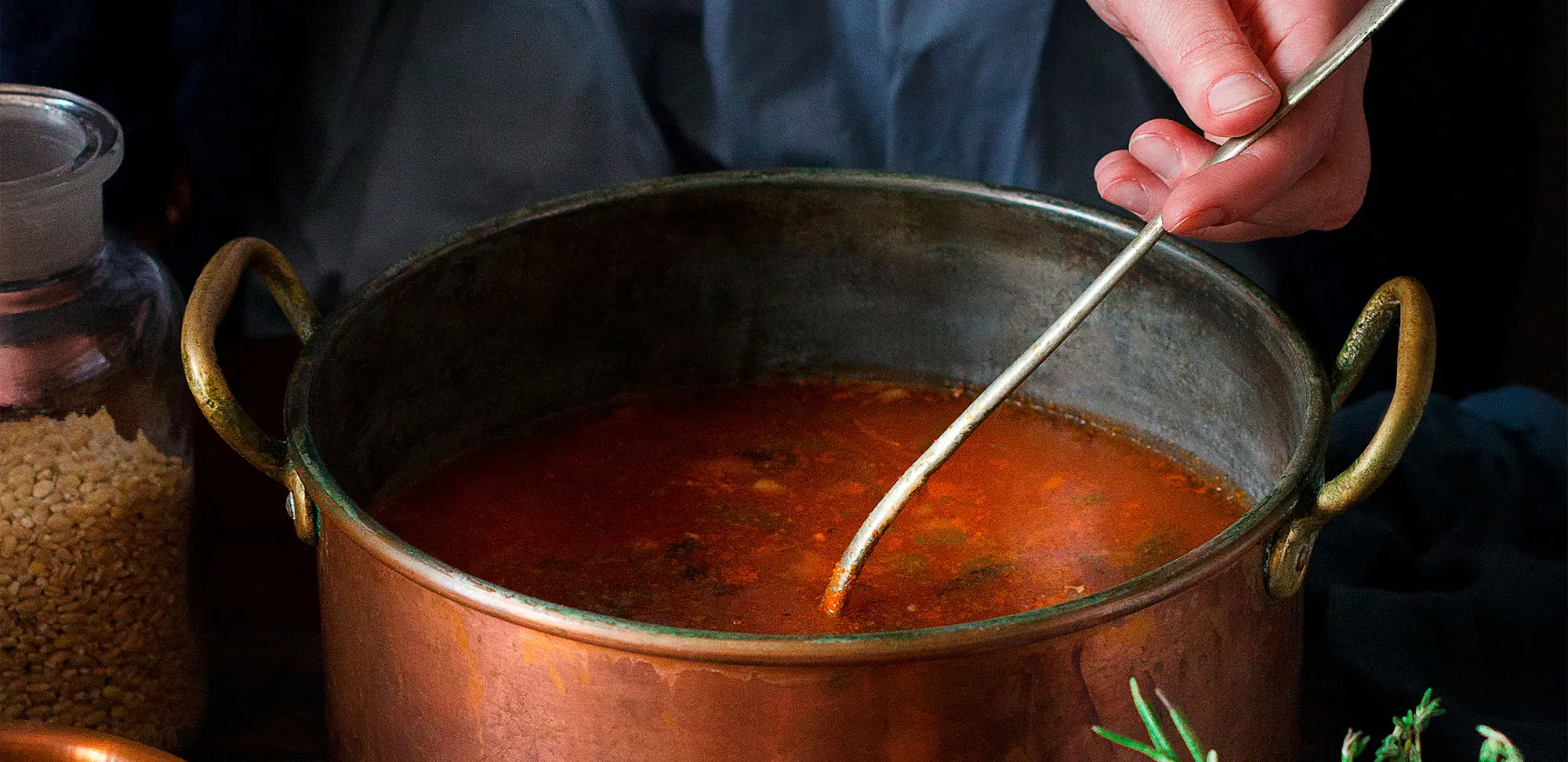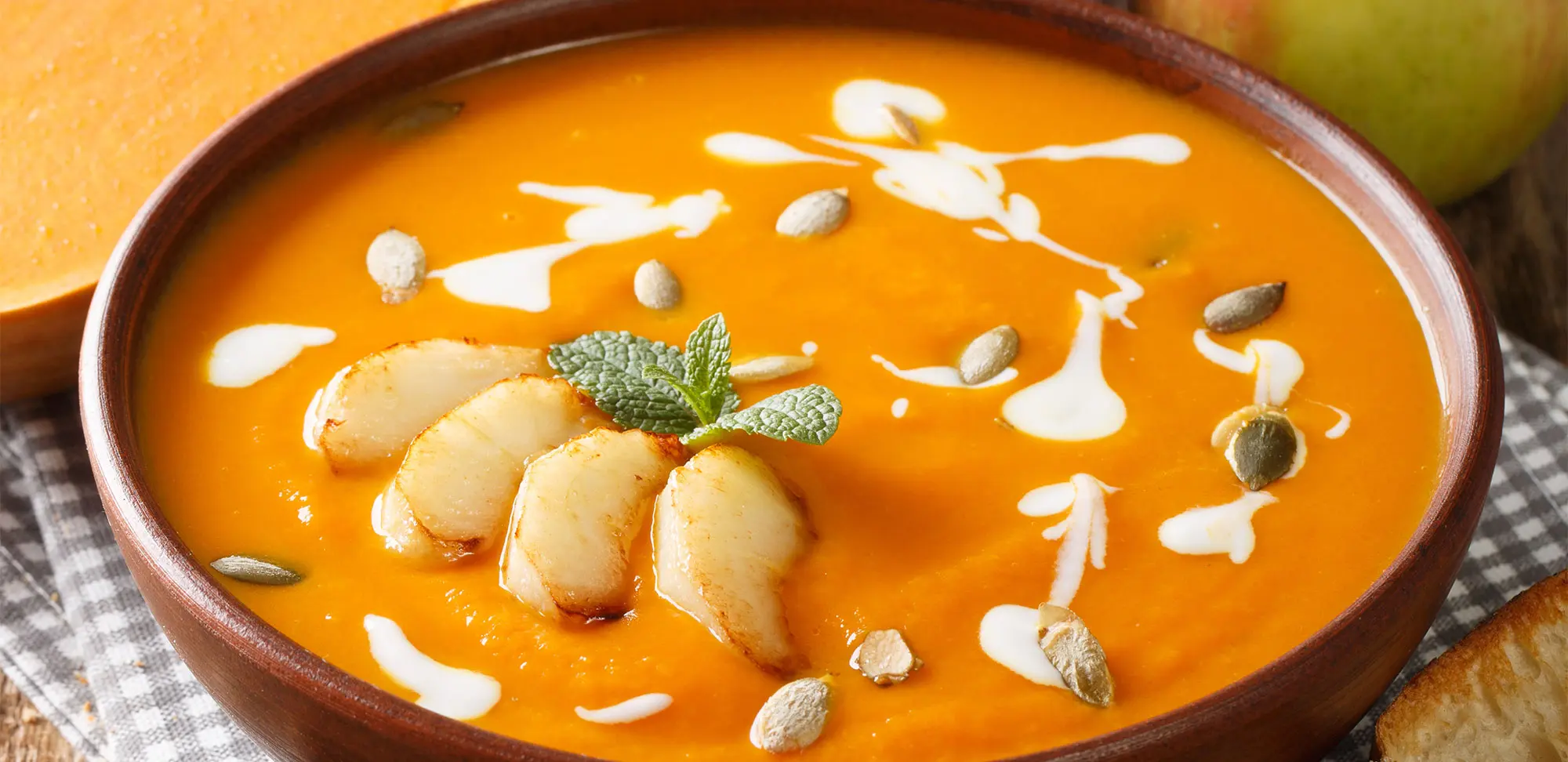Summer has its pleasures, and frankly, so do autumn and spring. But if we could look beyond drifting snow, slippery sidewalks and long dark nights, winter has its share of pleasures, too. One of my pleasures? Spending time in my kitchen, trying a new recipe, enjoying the rhythm of chopping and stirring, of slicing and savouring the aroma of hearty dishes as they simmer to perfection.
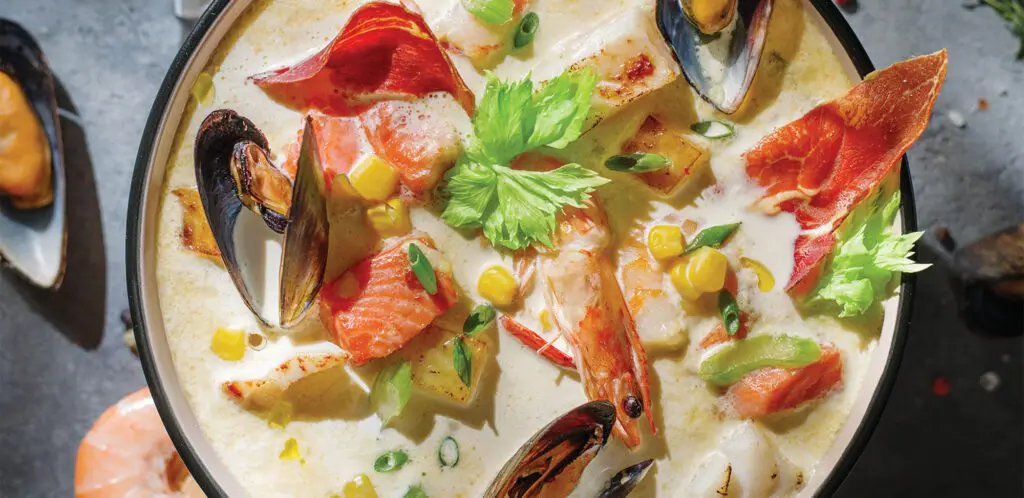
Easy Seafood Chowder
Cooking together is one of the coziest of activities, a little like a symphony — everyone has a part, and when the music (chowder) comes together in the song (bowl), magic takes over.
2 tbsp (30 mL) butter
2 cups (500 mL) cubed potatoes
2 tender stalks celery, diced
1 medium carrot, diced
1 onion, diced
1 tsp (5 mL) dried summer savoury or thyme
1/2 tsp (2 mL) freshly ground pepper
1 bay leaf
1 tbsp (15 mL) all-purpose flour
1/2 lb (225 g) cooked, shelled small shrimp
1 cup (250 mL) frozen corn kernels
2 cups (500 mL) 18% cream
1 cup (250 mL) frozen peas
2 cups chicken broth, low sodium preferred
Salt
Sour cream, optional
In a medium-large saucepan, melt the butter over medium-low heat. Stir in the potatoes, celery, carrot, onion, savoury, pepper and bay leaf. Cook, stirring from time to time, until slightly tender, about 8 minutes. Add the flour, stirring to coat the vegetables evenly.
Increase the heat to medium-high; pour in the stock and bring to a boil. Cover, reduce heat to simmer the soon-to-be-chowder for about 10 minutes, or until the vegetables are tender. If you like a slightly thicker soup, use a fork to mash some of the potatoes.
Add the shrimp, corn and cream; bring to a simmer. Simmer for 5 minutes. Stir in the peas; taste, adding salt if needed. Remove bay leaf. Serve piping hot with a dollop of sour cream, if desired.
Makes 4 supper-size bowls of chowder.
Substitution: Replace the shrimp with 8 oz (225 grams) of cubed raw cod or salmon; increase simmering time until fish becomes firm. Or, take advantage of your pantry supplies. A can of sockeye salmon, in chunks, can replace the shrimp. Add 1 tbsp (15 mL) of the juice from the can along with the salmon.
Tip: You can nestle a few mussels or bite-size chunks of salmon in with the shrimp.
Tip: You can substitute lighter cream (5% or 10%) or whole milk for the 18% cream called for in the recipe. Or, substitute one 12 oz (355 mL) can evaporated milk and an extra 1/2 cup (125 mL) of stock or water.
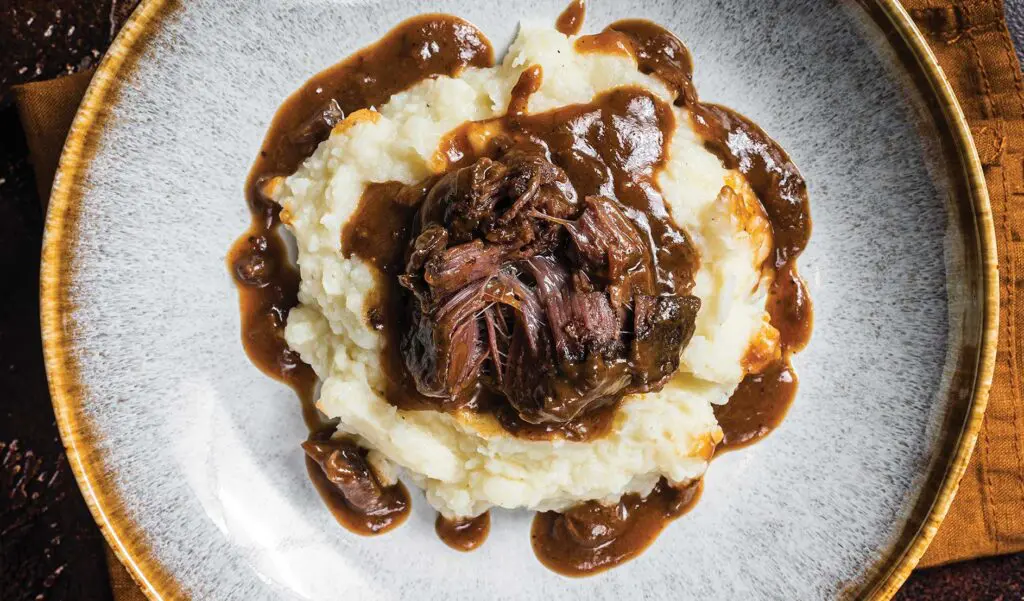
Braised Beef with Flashbacks of Summer
This dish ticks off all the boxes: make-ahead, no-fail, easy to serve to a holiday crowd. It fills the kitchen with robust aromas and is simply delicious over silky mashed potatoes or a wide long pasta such as pappardelle, even rice. In short, a crowd-pleaser.
3 lb (1.5 kilos) chuck beef roast
2 tbsp (30 mL) canola oil, approximate
1 large onion, minced
6 cloves garlic, minced
2 stalks tender celery, diced
1 carrot, diced
Salt and freshly ground pepper
2 tsp (10 mL) dried thyme
2 tsp (10 mL) smoked mild paprika
1 tsp (5 mL) dried oregano
2 bay leaves
1 tbsp (15 mL) grated orange rind
3 cups (750 mL) chicken or beef stock, sodium-reduced recommended, approximate
1/2 cup (125 mL) white or red wine
1/2 cup (125 mL) orange juice
2 tbsp (30 mL) balsamic vinegar
3 tbsp (45 mL) each all-purpose flour and soft butter
1/2 cup (125 mL) oil-cured wrinkly black olives
1/2 cup (125 mL) minced flat-leaf parsley
Make sure you have a large heavy-bottomed ovenproof pot or Dutch oven. Arrange an oven rack just below the centre of the oven. Twenty minutes before transferring the braised beef to the oven, turn the heat to 300°F (150°C).
With a sharp knife, trim away excess fat from the roast; cut the beef into 1½- to 2-inch (4 to 5 cm) cubes.
In a large heavy-bottomed pot or Dutch oven, heat the oil over medium high heat. Brown the beef in batches, leaving space between the beef cubes to sizzle rather than steam. Transfer to a plate. Leave all the tasty brown bits in the pot, but if there is more than 3 tbsp (45 mL) fat left in the pot, skim it off.
To the Dutch oven, add the onion, garlic, celery and carrot, then the salt and pepper, thyme, paprika, oregano, bay leaves and orange rind. Over medium-low heat, gently cook (sweat) this aromatic mixture until the vegetables have started to soften. Stir in the stock, wine, orange juice and vinegar. Cover and bring to a boil.
Transfer the Dutch-oven-of-deliciousness to the oven; braise for 1½ hours. Give the braised beef a good stir; cover and braise for about 1 hour more, or until the meat is fork tender and the sauce has reduced slightly and thickened. Remove the bay leaves. Mash together the flour and butter until smooth.
Move the Dutch oven onto the stovetop, and set over medium heat. Whisk a spoonful of the flour mixture (beurre manié) at a time into the braising liquid, adjusting the thickness as you wish. If you’d like more gravy, stir in additional stock. Stir in the olives. Taste and season if desired. Sprinkle the parsley overtop and dish it up.
Makes 6 to 7 generous servings.
Leftovers? You wish! But if there are any, cover the braised beef with a layer of mashed potatoes or a round of pastry, even biscuits. Or, spoon the beef over baked sweet potatoes. Pull the beef into shreds, moisten with the gravy and create a delicious filling for buns, pitas and tortillas.
Tip: An average navel orange yields about 1 tbsp (15 mL) grated orange rind and close to ½ cup (125 mL) orange juice. One average lemon yields 1 tbsp (15 mL) grated rind and ¼ cup (4 tbsp/60 mL) juice. If a list of ingredients calls for rind and juice, it’s easier to grate off the rind before squeezing out the juice.
Tip: Grind the black pepper fresh — chefs get around the last-minute fussing this entails by grinding up enough for each day’s dishes.
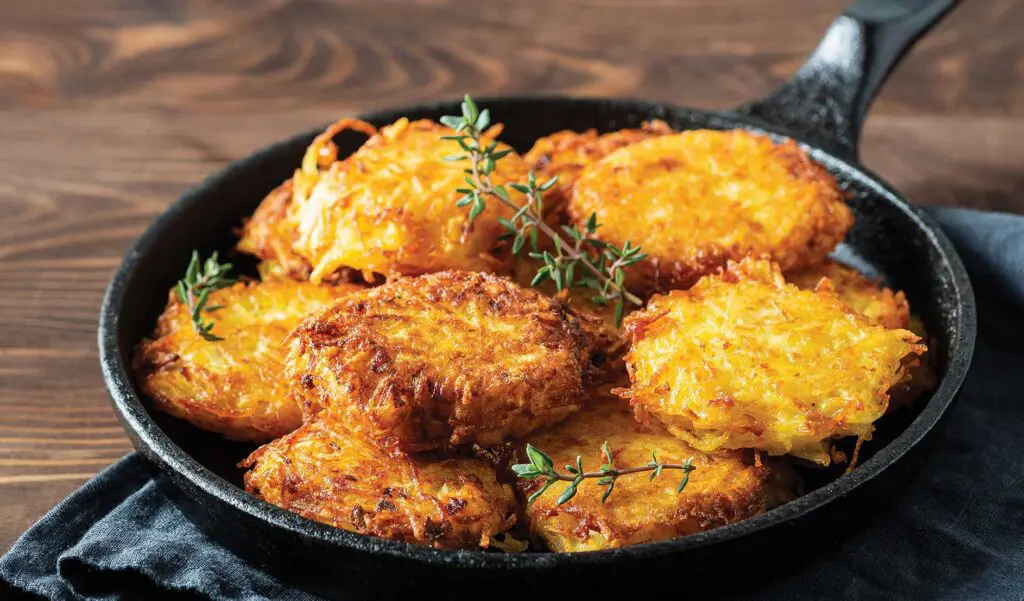
Golden Crisp Latkes
Turn a few humble potatoes into a feast. Shredding is not the most exciting cooking technique, but it transforms potatoes into a fine side, appetizer and a traditional Hanukkah treat.
6 oval baking potatoes, about 2½ lb (1¼ kilos), peeled
2 large eggs
1 tbsp (15 mL) finely chopped onion
2 tbsp (30 mL) all-purpose flour or matzo meal
1/2 tsp (2 mL) salt
1/4 tsp (1 mL) baking powder
1/2 cup (125 mL) canola oil, approximate
Line 2 rimmed baking sheets with paper towel and set aside.
Shred the potatoes on the medium side of a box grater or with a food processor’s shredding blade. Scoop the potatoes into a large bowl and cover with cold water. For a quick chill, add a layer of ice cubes and chill for 2 hours. Or, place bowl of potatoes in the fridge overnight.
Drain the potatoes well, then press and squeeze out the moisture. A salad spinner works well, too; whiz the potatoes in two batches.
In a separate large bowl, whisk the eggs until smooth. Whisk in the onion, flour, salt, baking powder, and finally, use a large wooden spoon to toss the potatoes with the batter.
In a large skillet, heat 2 tbsp (30 mL) of the oil until hot but not smoking. Add ¼ cup (60 mL) latke mixture for each latke, leaving about 1 inch (2½ cm) between latkes. Flatten slightly. Fry until golden brown and crisp around the edges, reducing heat if necessary to prevent burning, about 3 minutes. Turn and fry until crisp and golden, again about 3 minutes. Transfer to prepared baking sheets. Keep warm in the oven at 250°F (120°C).
Strain out any bits of potatoes from the oil. Repeat frying the potato mixture, adding and heating oil as needed.
Make-ahead: Let cool; layer with waxed paper and cover. Refrigerate up to 8 hours. Re-crisp in a single layer on baking sheets in 450°F (230°C) oven for about 5 minutes.
Makes about 24 latkes, enough for 4 to 6 servings.
Serving tip: Set out toppings — a sweet one of 1 cup (250 mL) sour cream and 2 cups (500 mL) applesauce, or go the savoury route with spreadable cream cheese, crème fraîche or sour cream topped with thinly sliced smoked salmon or chevron-shaped pieces of smoked trout plus scatterings of chopped dill, thin strips of red onion and capers. Thinly sliced cucumber is also a delicious topping.
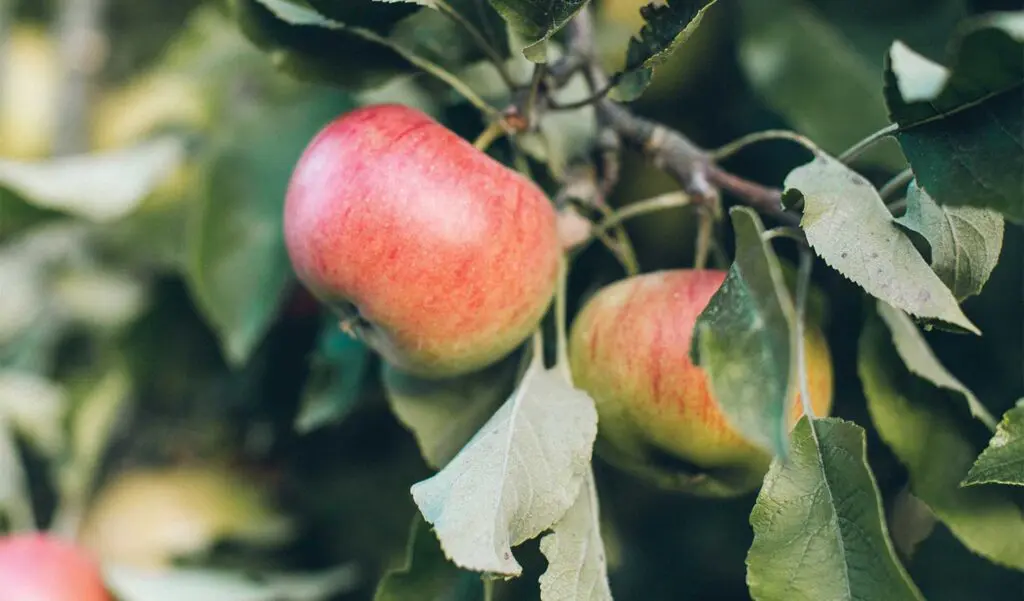
Apple and Berry Crisp Galette
A round of flaky pastry holds a juicy apple and cranberry filling, topped, apple crisp–like, with brown sugar and butter crumble. If you’ve never made a galette — a free-form pie; some call it rustic, with the bottom crust wrapping up and over most of the fruit filling — now’s the time in your cozy kitchen.
Set out a 14-inch (35 cm) pizza pan or large rimless baking sheet. Cut a 15-inch (38 cm) length of parchment paper. Arrange an oven rack in lower third of oven. When you start to roll out the pastry, preheat oven to 425°F (220°C).
Pastry:
2 cups (500 mL) all-purpose flour
2 tbsp (30 mL) granulated sugar
1/4 tsp (1 mL) salt
1 cup (250 mL) cold butter, cubed
1 tsp (5 mL) finely grated lemon rind
1 tbsp (15 mL) fresh lemon juice
Ice water
Crisp topping:
1/4 cup (60 mL) all-purpose flour
1/4 cup (60 mL) packed brown sugar
2 tbsp (30 mL) soft butter
Filling:
1/2 cup (125 mL) granulated sugar
1/4 cup (60 mL) all-purpose flour
1 tsp (5 mL) grated nutmeg
2 tsp (10 mL) finely grated lemon rind
6 cups (1,500 mL) sliced apples from 4 large apples such as Northern Spy, Cortland, Idared, Golden Delicious or Crispin
1 cup (250 mL) fresh or frozen cranberries
1 tbsp (15 mL) fresh lemon juice
Icing sugar
Pastry: In a food processor, combine the flour, sugar and salt. Add the butter; pulse until grainy with a generous sprinkling of pea-sized bits of butter. In a liquid measuring cup, combine the lemon rind and juice and enough water to make ½ cup (125 mL). Pour over the flour mixture. Pulse briefly just until it forms a ragged mixture. Scrape onto a flour-dusted work surface. With flour-dusted hands, gather the pastry together; knead briefly to bring the pastry together, and smooth out cracks. Flatten into a disc; wrap and refrigerate for 1 hour or up to 2 days. Let soften at room temperature, about 45 minutes, before rolling out.
Crisp topping: In a bowl with a fork, mash together the flour, sugar and butter; set aside.
Filling: In a small bowl, stir together the sugar, flour, nutmeg and lemon rind. Spoon over the fruit, sprinkle on lemon juice and toss well.
Sprinkle the parchment paper lightly with flour. Using a floured rolling pin, roll out the pastry to a 14-inch (35 cm) round, leaving the edge untrimmed. Slide paper and pastry round onto the pizza pan. Spoon the filling over the pastry, leaving a 4-inch (10 cm) border uncovered. Sprinkle the crisp topping over the filling. Lift the pastry up over the filling to form a 10-inch (25 cm) circle, letting the pastry fall naturally into folds around the edge and leaving the centre uncovered.
Bake for 20 minutes. Reduce heat to 375°F (190°C). Bake until the apples are tender, the filling is bubbling and the pastry golden, about 40 minutes. Slide galette and paper onto a rack to cool. With a wide spatula, or two for support, slide the galette onto a flat cake plate or a dining-table-worthy pizza pan. If desired, dust the galette with icing sugar. Use a pizza cutter to cut into 8 to 10 servings.
Make-ahead: Ideally, serve the galette while it’s still warm from the oven. But you can let it stand at room temperature for up to a few hours. Reheat if desired, and serve with whipped cream or crème fraîche.
Tip: If you can find frozen (or fresh, in season) haskap berries, try them instead of cranberries. This “newish” addition to cultivated Canadian berries is a beautiful midnight blue, oval in shape, and tangy.
